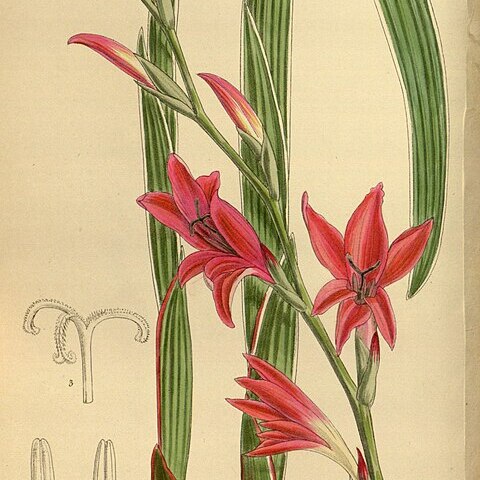Flowers orange-red to pink, rarely yellow to whitish, without markings; perianth tube (12)18–20(30) mm long, widening evenly from the base, gently curving outwards; tepals unequal, the upper 3 tepals 25–38 × 15–18 mm and strongly recurved distally, the uppermost horizontal or down-tilted, the upper lateral tepals slightly narrower and directed forwards, the lower tepals curving downwards, the lower lateral tepals c. 25 × 12–15 mm, the lowermost 30–35 mm long, often about as long as the upper.
Leaves borne on the flowering stem usually partly to entirely sheathing, hardly differing from the cataphylls,(1)2–3(more), sometimes with short blades 2–5(10) cm long, often partly dry by anthesis, occasionally flowering stems with 1–2 long-bladed leaves; foliage leaves produced after the flowers and on separate shoots, evidently solitary, ultimately at least 30 × c. 1 cm, lanceolate, the margins and midrib moderately thickened and hyaline.
Spike 5–9(12)-flowered; bracts green, often flushed reddish and becoming membranous above, (15)20–28(35) mm long, the inner slightly shorter than the outer.
Corms 2.5–3.5 cm in diameter; tunics straw-coloured, coriaceous, fragmenting irregularly, the outer layer sometimes becoming fibrous.
Filaments 8–10 mm long, included in the upper pan of the tube; anthers 10–12 mm long.
Style dividing 2–3 mm beyond the apex of the anthers, style branches 6–8 mm long.
Stem simple, rarely branched, 3–4 mm in diameter at the base of the spike.
Capsules 15–20(25) mm long, oblong to ellipsoid.
A herb with almost leafless stems 2-3 ft. high
Plants 25–40(60) cm high.
Pale pink flowers

